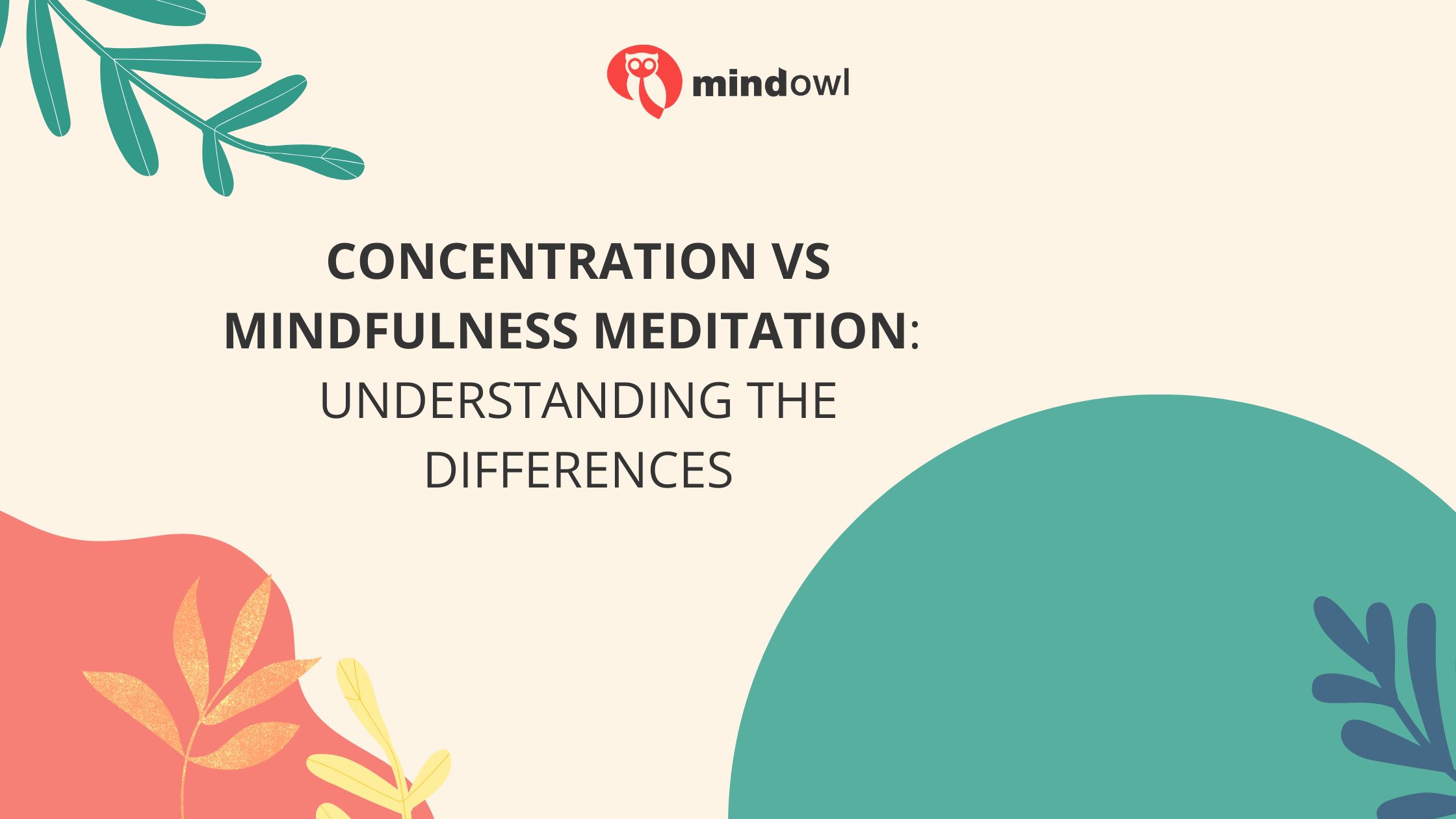Meditation comes in many forms, two of the most common being concentration meditation and mindfulness meditation. Concentration meditation involves focusing the mind on a single object, like the breath or a mantra. This builds mental strength and focus. Mindfulness meditation is about opening up awareness to observe all sensations without judgment. It cultivates acceptance and insight.
Both concentration and mindfulness meditation have value on the spiritual path. Concentration builds mental power, while mindfulness builds wisdom. Ideally, they work together in a balanced practice – concentration provides a focused anchor to keep bringing the attention back to, while mindfulness allows us to fully experience each moment without attachment.
In this article, we will be examining the differences and synergies between concentration and mindfulness meditation from the perspective of personal practice – how to combine them effectively. The goal is to find the right balance for your own needs and temperament.
Key Takeaways
- Mindfulness meditation, stemming from Vipassana in Buddhist teachings, is about being aware and accepting of the present moment.
- Concentration meditation, known as samadhi in Buddhism, focuses on a single object or idea to train the mind for deep focus.
- While concentration builds a sharper focus needed for tasks that require sustained attention, mindfulness aids emotional regulation by fostering awareness of one’s thoughts and feelings.
- Practising mindfulness can be woven into daily activities like eating or walking to enhance presence throughout the day.
- Concentration meditation usually requires setting aside a specific time in a quiet space for focused practice.
- Implementing both forms of meditation can lead to increased calmness, better stress management skills, enhanced clarity of thought, improved attention spans and patience levels.
The Origins of Concentration and Mindfulness Meditation

Concentration and mindfulness meditation have their roots in ancient Buddhist texts. Concentration, known as samadhi, involves focusing attention on a chosen object, while mindfulness, also called Vipassana, centres on cultivating open awareness of the present moment.
These practices have since been adapted and incorporated into various forms of meditation used today.
Concentration as samadhi in Buddhist texts
Buddhist texts refer to concentration as samadhi. This is a state of deep focus and absorption. It is where the mind becomes completely still on one object or idea. The goal of samadhi is to calm the mind and reduce distractions, leading to greater clarity and relaxation.
Achieving this zen-like state can help someone manage stress more effectively.
Practising samadhi involves repeated focus, usually on something like breathing or a mantra. This kind of meditation strengthens attention and fosters a peaceful detachment from worries.
As you train your mind, distractions slip away more easily over time, helping with anxiety symptoms. Through such focused practice, individuals can experience mental health benefits like increased calmness and improved stress management.
Mindfulness as Vipassana in Buddhist texts
Shifting focus from samadhi, Vipassana introduces a different aspect of meditation. In Buddhist teachings, Vipassana stands for “clear seeing” or insight. This practice sharpens the mind’s ability to see things as they really are.
Meditators cultivate mindfulness by observing their thoughts and feelings without judgment. They watch sensations come and go, learning about the nature of impermanence.
Vipassana seeks to develop deep understanding through direct experience. Practitioners gain insight into the true nature of reality by being mindful of every moment. The goal is not just to concentrate but also to perceive clearly what is happening within oneself.
This awareness brings wisdom and leads to enlightened states beyond ordinary consciousness.
Exploring Concentration Meditation
In concentration meditation, you keep your attention steady on a single point. This could be your own breathing, a mantra, or even a candle flame. The idea is to let go of all other thoughts and distractions.
By doing this, you train your mind to become calm and focused. It’s like using a magnifying glass to direct sunlight onto one spot; concentration meditation harnesses all your mental power onto one thing.
This type of practice helps clear away the noise in your head. As you get better at it, maintaining focus becomes easier. It might start with just a few minutes before distractions creep in but over time, people can hold their focus for longer periods.
Benefits of concentration meditation
Concentration meditation brings many advantages that can improve everyday life. Here are some benefits of concentration meditation:
- It boosts calmness: When you train your mind to concentrate, you naturally feel more peaceful and relaxed.
- This type of meditation helps with stress: Focusing deeply on one thing takes your mind off worries and stresses.
- Concentration meditation can make you patient: Sticking with one focus point teaches you how to wait calmly.
- It sharpens your attention span: Regular practice makes it easier to keep your mind on tasks without getting distracted.
- The practice promotes mental clarity: With improved focus, thoughts become clearer and less jumbled.
- It lays the groundwork for other forms of meditation: Strong concentration is a key part of mindfulness and other advanced techniques.
- Concentration meditation encourages emotional stability: By concentrating, you learn to stay even-minded, even in tough situations.
Exploring Mindfulness Meditation
Mindfulness meditation aims to develop self-awareness. It helps people become more aware of their thoughts and feelings without judgment. Practising mindfulness means paying attention to what’s happening right now.
This focus on the present can reduce stress and anxiety by keeping future worries at bay.
Through mindfulness exercises, individuals learn to observe their inner experiences closely. They notice thoughts, emotions, and bodily sensations as they arise. This observation leads to a deeper understanding of oneself, fostering calmness and insight.
Mindfulness is not about changing these experiences but accepting them, which helps in managing anxiety effectively.
Incorporating mindfulness into daily life
- Start your day with a few minutes of deep breathing. Sit quietly and focus on your breath as it flows in and out.
- Eat meals mindfully. Chew slowly, savour every bite, and pay attention to the taste, texture, and aroma.
- Take short breaks during the day for mindful moments. Pause to notice sensations like the sun on your skin or the breeze in your hair.
- Engage fully in whatever you’re doing. When walking, notice each step; when listening, hear every word.
- Use everyday tasks as reminders to be present. Washing dishes or showering can become opportunities for mindfulness.
- Practise gratitude by reflecting on things you’re thankful for each day. Notice simple pleasures like a warm cup of tea or a friendly smile.
- Listen mindfully in conversations. Focus on understanding the speaker without thinking about how to respond.
- Set aside time for a formal mindfulness meditation session daily. Concentrate on being present without any distractions.
- Be patient with yourself as you learn this skill. Mindfulness takes practise and doesn’t develop overnight.
Key Differences between Concentration and Mindfulness Meditation
Object of focus vs. open awareness
In concentration meditation, you zoom in on one thing. It could be your breath or a mantra. Your whole mind sticks to this single point of attention. If thoughts come, you gently let them go and bring your focus back.
Mindfulness meditation is different. You don’t just pick one thing to watch over. Instead, you become aware of everything without sticking to any of it. Thoughts, feelings, sounds – they all pass by like clouds in the sky while you observe from a distance.
This practice helps you notice patterns in your thoughts and emotions without getting caught up in them.
Formal vs. informal practice
Formal meditation practices, such as concentration meditation, follow a structured approach with specific techniques and are often conducted in a designated quiet space. They require focused attention on a chosen object or mantra to cultivate deep concentration.
On the other hand, informal mindfulness meditation allows for flexibility and can be integrated into daily activities, providing the opportunity to practice mindfulness anywhere and at any time.
Mindfulness encourages open awareness and reflection on thoughts without the need for a set routine or location.
Importance of both types of meditation
Mindfulness and concentration are two essential components of a well-rounded meditation practice.
As mindfulness involves cultivating an open, non-judgmental awareness of the present moment, this quality of mindful awareness is crucial for developing insight into the nature of our experience and for responding to life’s challenges with greater wisdom and equanimity.
At the same time, concentration or focused attention is also vital. The ability to maintain attention on a single object, like the breath, anchors the mind and prevents it from becoming distracted. Concentration provides the stillness and stability that allows mindfulness to deepen.
A complete meditation practice involves first using concentration to temporarily calm and unify the mind, and then expanding this collected awareness into a wider, mindful presence. Mindfulness and concentration therefore work together in a balanced way – mindfulness directs the laser-like focus of concentration towards an open, receptive observation of the present moment.
Conclusion
Understanding the differences between mindfulness meditation and concentration meditation is crucial for harnessing their unique benefits. Mindfulness meditation focuses on self-awareness and processing emotions to cultivate calmness and insight, while concentration meditation enhances attention and reduces distractions through single-pointed focus.
These practices complement each other beautifully—offering a balance between deep focus and gentle awareness in your life. Engage with both to see what works best for you. Happy meditating!
FAQs
1. What’s the difference between mindfulness meditation and concentration meditation?
Mindfulness meditation is about being aware of your thoughts as they come and go, while concentration meditation focuses on holding your attention on a single object or thought.
2. How do you practice mindfulness meditation?
To practice mindfulness meditation, find a quiet place to sit comfortably, pay attention to your breath, and gently acknowledge any thoughts without judgment before letting them pass.
3. Can concentration meditation help me regain focus?
Yes, a concentration meditation session can train your mind to return its focus to one point or object of concentration whenever it drifts away.
4. Are there different benefits for each type of meditation?
Indeed, both types bring unique benefits; mindfulness leads to awareness of the present moment while concentration develops deep mental clarity and focus.
5. Does practising one kind of mediation exclude the other?
No, individuals often combine both practices because attention and right concentration are essential for developing full mindfulness in daily life.
6. Is it possible to develop mindfulness by force through sheer willpower alone?
No, true mindfulness is cultivated with patience over time rather than forced through effort; it allows insights into feelings that could distract us from being present.
MindOwl Founder – My own struggles in life have led me to this path of understanding the human condition. I graduated with a bachelor’s degree in philosophy before completing a master’s degree in psychology at Regent’s University London. I then completed a postgraduate diploma in philosophical counselling before being trained in ACT (Acceptance and commitment therapy).
I’ve spent the last eight years studying the encounter of meditative practices with modern psychology.


